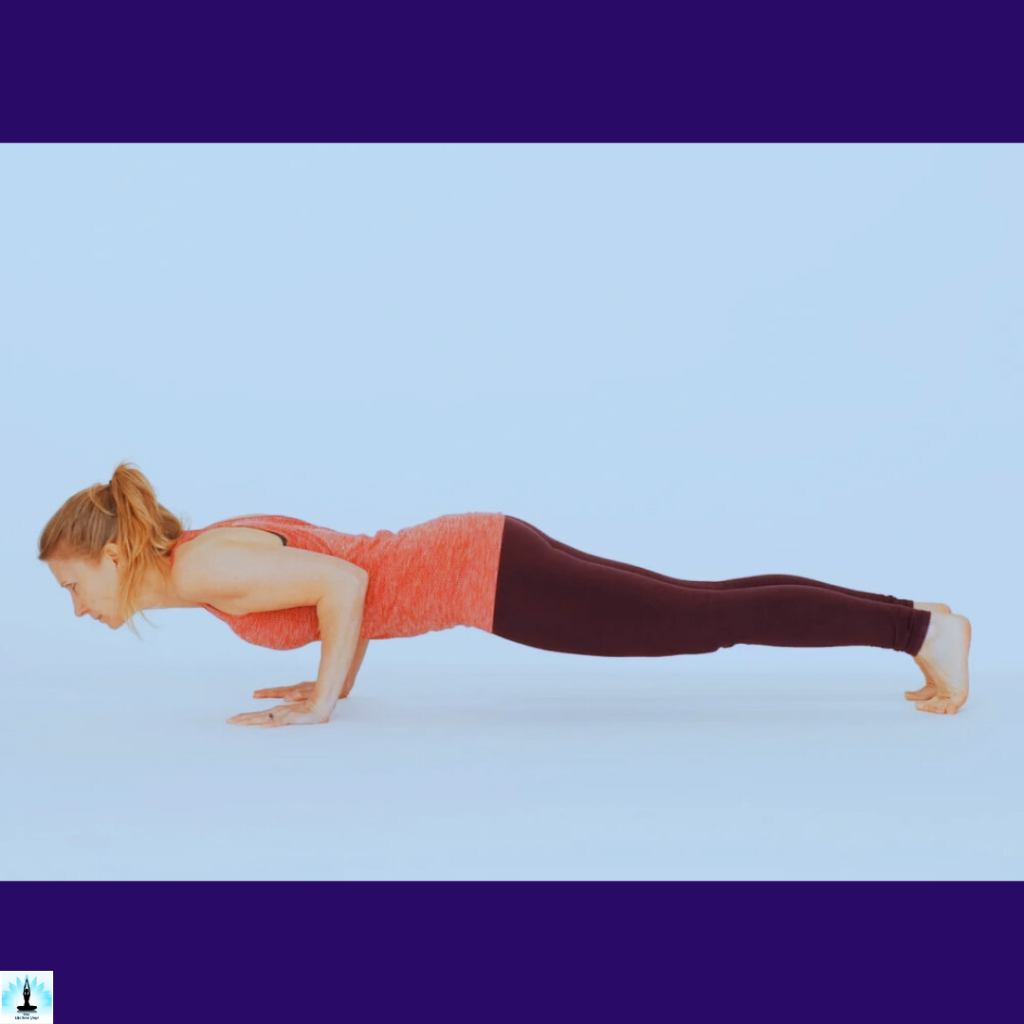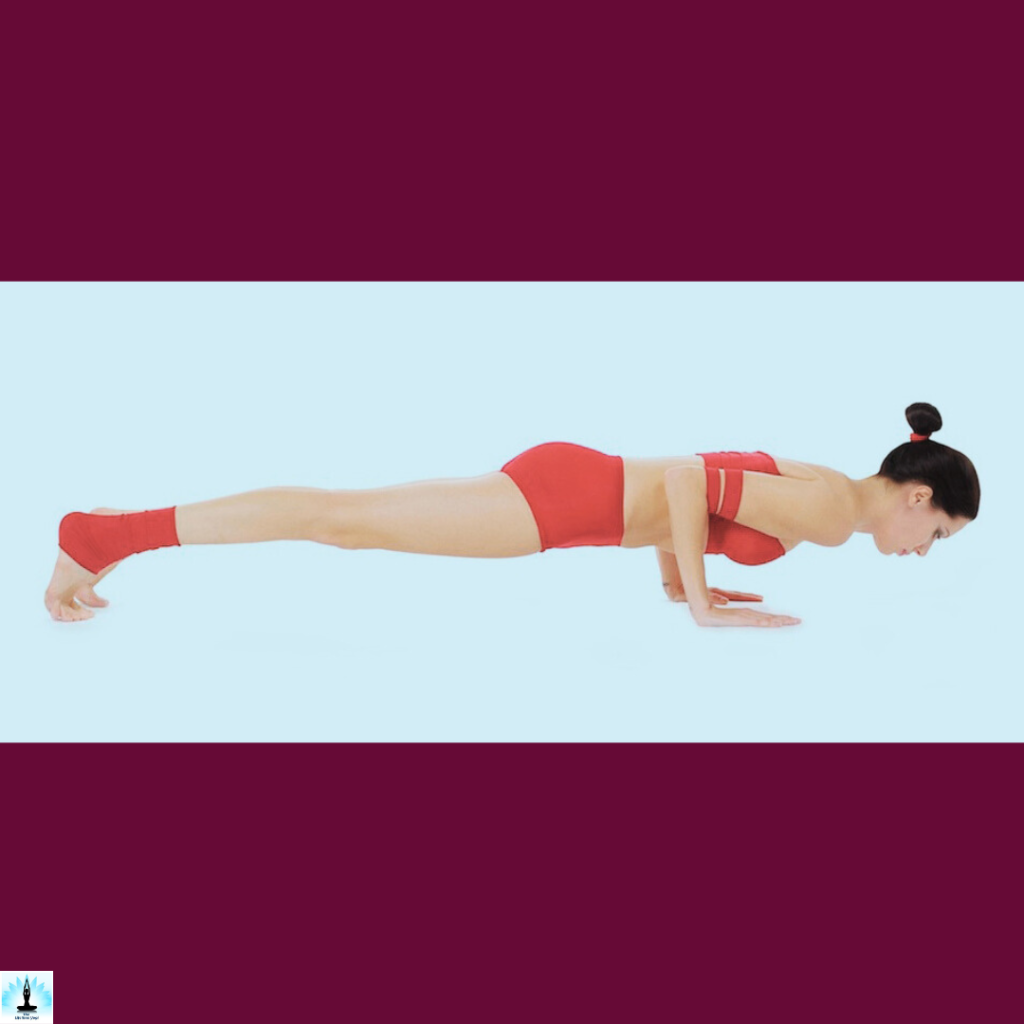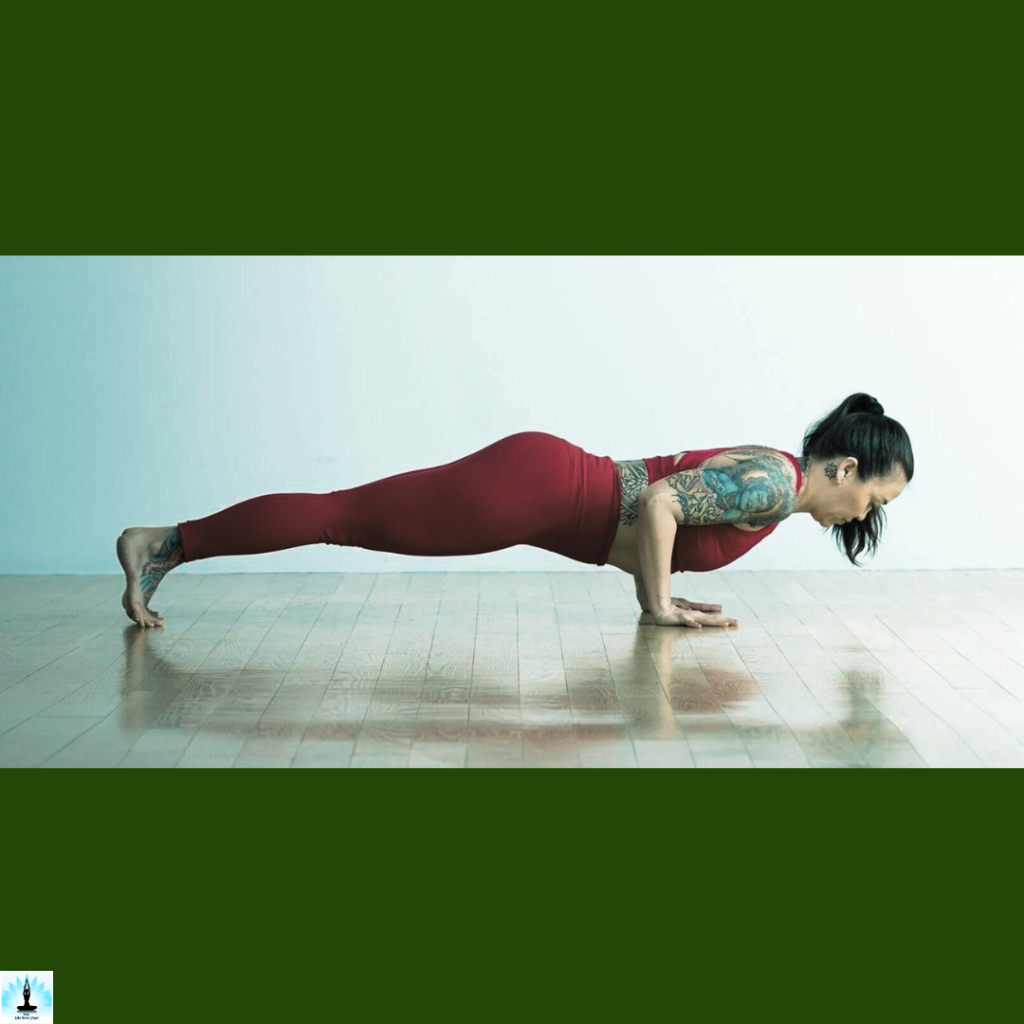Table of Contents
Chaturanga Dandasana / Four Limbed Staff Pose
Introduction
In the world of yoga, Chaturanga Dandasana, also known as the Four-Limbed Staff Pose, holds a special place as one of the fundamental building blocks of a vinyasa flow practice. Derived from the Sanskrit words “Chatur” (four), “Anga” (limb), and “Danda” (staff), this asana requires strength, stability, and precision.
Though it may seem straightforward at first glance, Chaturanga Dandasana demands a deep understanding of alignment and a strong core to avoid unnecessary strain on the shoulders and wrists. In this blog, we will delve into the beauty and challenges of Chaturanga Dandasana, exploring its benefits, proper alignment, and modifications.
The yogic philosophy of the Chaturanga Dandasana
The yogic philosophy of Chaturanga Dandasana encompasses the concept of balance, discipline, and mindfulness. This asana teaches us to find harmony within ourselves and the world around us. The balance required to hold the pose reflects the need for equilibrium in our lives, enabling us to navigate the dualities and challenges with grace and poise. It symbolizes the strength and resilience necessary to face life’s obstacles, encouraging us to cultivate inner power and determination.

Chaturanga Dandasana derives its name from the Sanskrit language, where each element holds a specific meaning:
Chaturanga: “Chatur” means four, and “Anga” translates to limb. In this context, it refers to the four limbs involved in the pose – two arms and two legs.
Danda: “Danda” means staff or stick. It refers to the straight, plank-like position of the body resembling a staff or a straight line.
Yogi yogendra
Thus, when we combine these terms, Chaturanga Dandasana can be translated as the “Four-Limbed Staff Pose.” The name perfectly encapsulates the fundamental aspects of the asana, where the body is supported by the strength of the arms and feet while maintaining a straight and firm posture resembling a staff. The pose is also sometimes called “Low Plank Pose” or “Yoga Push-Up” in English due to its similarity to a low push-up position in modern exercise routines.
Benefits of Chaturanga Dandasana
Chaturanga Dandasana offers a plethora of physical, mental, and emotional benefits when practiced correctly and consistently. Let’s explore some of the significant advantages of incorporating this pose into your yoga practice:

- Strengthens the Upper Body: Chaturanga primarily targets the muscles in the arms, shoulders, chest, and upper back. Regular practice helps build strength in these areas, enhancing overall upper body endurance and stability.
- Core Activation: To maintain proper alignment in Chaturanga, you need to engage your core muscles actively. This constant core activation helps strengthen and tone the abdominal muscles.
- Improves Posture: The pose promotes an aligned and elongated spine, which can help improve overall posture and reduce the risk of developing rounded shoulders or a hunched back.
- Builds Endurance: Holding Chaturanga for an extended period challenges the muscles, building endurance and stamina. This increased endurance can benefit other physical activities and daily tasks.
- Prepares for Arm Balances: Chaturanga serves as an essential preparatory pose for more advanced arm balances in yoga. It helps condition the arms and shoulders for poses like Crow Pose (Bakasana) and Eight-Angle Pose (Astavakrasana).
- Tones the Legs: While the focus is on the upper body, the muscles in the legs also get engaged and toned in Chaturanga, contributing to overall lower body strength.
- Mindfulness and Concentration: Holding Chaturanga requires focus and concentration on breath and alignment. This cultivates mindfulness and helps calm the mind during practice.
- Body Awareness: Regularly practicing Chaturanga enhances body awareness as you learn to align and adjust your body to maintain the pose correctly.
- Develops Discipline: Consistent practice of Chaturanga builds discipline and determination, as the pose demands correct alignment and strength.
- Full-Body Integration: Chaturanga synchronizes the movement of the entire body, encouraging holistic integration of body, mind, and breath.
Four-Limbed Staff Pose: Step-by-Step Instructions
The Four-Limbed Staff Pose, Chaturanga Dandasana, may seem simple at first glance, but mastering its alignment and technique requires practice and attention to detail. Here’s a step-by-step guide to performing Chaturanga Dandasana correctly:

1. Starting Position:
Begin in a high plank position with your shoulders directly over your wrists, fingers spread wide, and your body forming a straight line from head to heels. Engage your core muscles by drawing your navel towards your spine.
2. Shift Forward:
As you exhale, shift your body weight forward, coming onto the balls of your feet. Your shoulders should move slightly past your wrists, and your elbows should point backward, close to your ribcage.
3. Lower Down:
Lower your body in a straight line by bending your elbows. Keep your upper arms parallel to the floor. Your chest should be in line with your elbows, forming a 90-degree angle at your elbows. Be mindful not to collapse the shoulders or dip the hips.
4. Align Your Body:
Ensure your body remains in a straight line from head to heels. Avoid letting your hips sag or lift too high, as this can strain the lower back.
5. Engage Your Core:
Keep your abdominal muscles engaged throughout the pose to support your lower back and maintain stability.
6. Hold and Breathe:
Hold the pose for a few breaths, maintaining a steady and even breath. Keep the neck long and gaze slightly forward, avoiding any strain on the neck.
7. Transition:
To transition out of Chaturanga, either press back up to a high plank position, or flow into Upward Facing Dog (Urdhva Mukha Svanasana) by rolling over your toes and lifting your chest while keeping your legs off the ground.
Advance Variations of Chaturanga Dandasana
As you become more proficient in Chaturanga Dandasana and develop greater strength and control, you may explore advanced variations of the pose. However, it’s crucial to approach these variations with caution and respect for your body’s limitations. Always warm up properly and listen to your body to avoid injury. One of the advance variation can be Chaturanga to Handstand Press.
Chaturanga to Handstand Press: Begin in Chaturanga and gradually shift your weight onto your hands. With control and engagement of the core, lift your legs up into Handstand. This advanced transition requires significant upper body and core strength, as well as a solid understanding of Handstand alignment.
Therapeutic Applications of Chaturanga Dandasana
Chaturanga Dandasana, commonly known as the Four-Limbed Staff Pose, holds various therapeutic applications that make it a valuable addition to a yoga practice. This pose helps in strengthening the core, arms, and wrists while promoting proper alignment and posture.
The isometric engagement of muscles in Chaturanga enhances body awareness and stability, making it beneficial for individuals recovering from shoulder, wrist, or elbow injuries. Moreover, the pose also aids in toning the abdominal region and improving overall body coordination.
Practicing Chaturanga Dandasana regularly can contribute to building endurance and preventing injuries in other physical activities. Beyond its physical benefits, this pose encourages mental focus and mindfulness, making it an excellent tool for stress reduction and promoting a sense of calm and balance in one’s daily life.
Poses Related to Chaturanga Dandasana
Preparatory Poses
One-Legged Chaturanga: From the standard Chaturanga position, lift one leg off the ground, keeping it engaged and parallel to the floor. This variation intensifies the core engagement and challenges the stability of the pose. Alternate between legs or hold for a few breaths on each side.
Eka Pada Koundinyasana Chaturanga Transition: From Chaturanga, shift your weight to one side, allowing the opposite leg to float up and cross over the other leg. Extend the lifted leg forward and transition into Eka Pada Koundinyasana (Sage Koundinya Pose). This transition requires arm and core strength, as well as open hips and hamstrings.
Follow-up Poses
Chaturanga to Bakasana (Crow Pose) Transition: Start in Chaturanga and lean forward, shifting your weight onto your hands. Bend your elbows slightly and bring your knees toward your upper arms. Gently lift your feet off the ground, coming into Bakasana or Crow Pose. This flow requires a strong core and upper body strength.
Chaturanga to Upward Facing Dog to Eka Pada Rajakapotasana (King Pigeon Pose) Flow: After Chaturanga, move into Upward Facing Dog. From there, bring one leg forward, bending the knee and placing the foot near your opposite hand. Transition into Eka Pada Rajakapotasana by gently lowering your back leg to the floor and deepening the stretch in your hip flexors and quadriceps.
Beginner’s Tip of Chaturanga Dandasana
For beginners attempting Chaturanga Dandasana, it is crucial to focus on proper alignment and avoid potential strain or injury. Start by placing emphasis on maintaining a strong and stable core throughout the pose. As you lower into the position, ensure your elbows are bent at a 90-degree angle, positioned directly above the wrists.
Avoid the common mistake of letting the elbows splay outwards or flaring, which can put excessive pressure on the shoulders. Instead, engage the muscles of the arms and shoulders to create a supportive foundation.
If you find it challenging to maintain the correct form, it is perfectly acceptable to modify the pose by lowering the knees to the floor until you build enough strength to perform the full pose. Remember to keep the spine aligned and avoid sagging or arching the back.
Contraindications and Cautions of Chaturanga Dandasana
While Chaturanga Dandasana offers numerous benefits, it is essential to be mindful of its contraindications and exercise caution, particularly for individuals with specific health conditions.
People with wrist injuries or carpal tunnel syndrome should avoid putting excessive pressure on their wrists in this pose.
Individuals with lower back problems or weak core muscles may also find this pose challenging, as it can strain the lumbar region if not performed with proper alignment.
Pregnant women should avoid deepening into Chaturanga, especially during the later stages of pregnancy, as it puts pressure on the abdominal area.
As with any yoga pose, it is crucial to listen to your body and avoid pushing yourself beyond your limits. Modifications or opting for alternative poses may be more suitable for those with specific health concerns, ensuring a safe and enjoyable yoga practice.
FAQ’s on Chaturanga Dandasana
1. What is Chaturanga Dandasana?
Chaturanga Dandasana, also known as Four-Limbed Staff Pose, is a yoga asana that involves holding a low plank position with the body parallel to the ground, supported by the hands and toes. The pose is commonly practiced in vinyasa or flow-based yoga sequences.
2. What are the benefits of practicing Chaturanga Dandasana?
Chaturanga Dandasana offers several benefits, including strengthening the core, arms, and wrists. It helps improve upper body strength, tones the abdominal muscles, and promotes better body alignment and posture. Regular practice of this pose can also enhance body awareness, stability, and mental focus.
3. Can beginners attempt Chaturanga Dandasana?
Yes, beginners can try Chaturanga Dandasana, but it’s essential to approach it with caution. Beginners should focus on proper alignment and engage the core and arm muscles to avoid strain or injury. Modifications, such as lowering the knees to the floor, can be adopted to build strength gradually.
4. What are the contraindications of Chaturanga Dandasana?
Chaturanga Dandasana may not be suitable for individuals with wrist injuries, carpal tunnel syndrome, or shoulder issues like impingements or rotator cuff injuries. It is also not recommended for those with lower back problems or weak core muscles. Pregnant women should avoid deepening into the pose due to increased abdominal pressure.
5. How can I avoid shoulder strain in Chaturanga Dandasana?
To avoid shoulder strain, ensure that your elbows are bent at a 90-degree angle, directly above the wrists, and avoid flaring them outwards. Engage the arm and shoulder muscles to create a stable foundation, and consider modifying the pose or using props if you experience discomfort.
6. Is Chaturanga Dandasana a weight-bearing pose?
Yes, Chaturanga Dandasana is a weight-bearing pose as it requires supporting the body’s weight on the hands and toes. It helps build strength in the upper body, particularly the arms, shoulders, and core.
7. Can Chaturanga Dandasana help with stress relief?
Yes, like many yoga poses, Chaturanga Dandasana can help with stress relief and promote a sense of calm and mental focus. The practice of yoga, including this pose, often incorporates mindfulness and breath awareness, contributing to overall relaxation.
8. How can I progress in Chaturanga Dandasana?
To progress in Chaturanga Dandasana, focus on building upper body and core strength through regular practice. Gradually lower yourself with control during the descent, and work on holding the pose for longer durations. Seek guidance from a qualified yoga instructor for personalized tips and modifications.
9. Can Chaturanga Dandasana be done as part of a home practice?
Yes, Chaturanga Dandasana can be incorporated into a home yoga practice. However, it’s essential to maintain proper alignment and perform the pose mindfully. Beginners may benefit from online tutorials or virtual classes to ensure they are practicing correctly and safely.
10. How can I prevent injuries in Chaturanga Dandasana?
To prevent injuries, focus on proper alignment, engage the core and arm muscles, and avoid putting excessive strain on the wrists and shoulders. If you have specific health concerns or limitations, consider consulting a healthcare professional or experienced yoga instructor for personalized guidance.
Conclusion
In conclusion, Chaturanga Dandasana, the Four-Limbed Staff Pose, is a powerful yoga asana with a multitude of benefits and considerations. This pose is an excellent tool for building upper body strength, particularly in the arms, shoulders, and core. Regular practice can lead to improved body awareness, stability, and posture. Proper alignment and modifications are essential to prevent strain or injury, particularly for the wrists, shoulders, and lower back. Despite its challenges, Chaturanga Dandasana offers an opportunity for mindfulness and stress relief, contributing to a balanced and holistic yoga practice.
Further reading
References
- Sinha, S. C. (1 June 1996). Dictionary of Philosophy. Anmol Publications. p. 18. ISBN 978-81-7041-293-9.
- Sjoman, Norman E. (1999) [1996]. The Yoga Tradition of the Mysore Palace. Abhinav Publications. pp. 54–55, 100–101. ISBN 81-7017-389-2.
- Iyengar 2005, p. 54-55.
- Active Interest Media (1984). Yoga Journal. Active Interest Media. p. 19.
- Kaminoff 2007, p. 183.
- “Surya Namaskara A – Sun Salutation”. Ashtanga Yoga. Archived from the original on 2012-03-11. Retrieved 2012-03-17.
